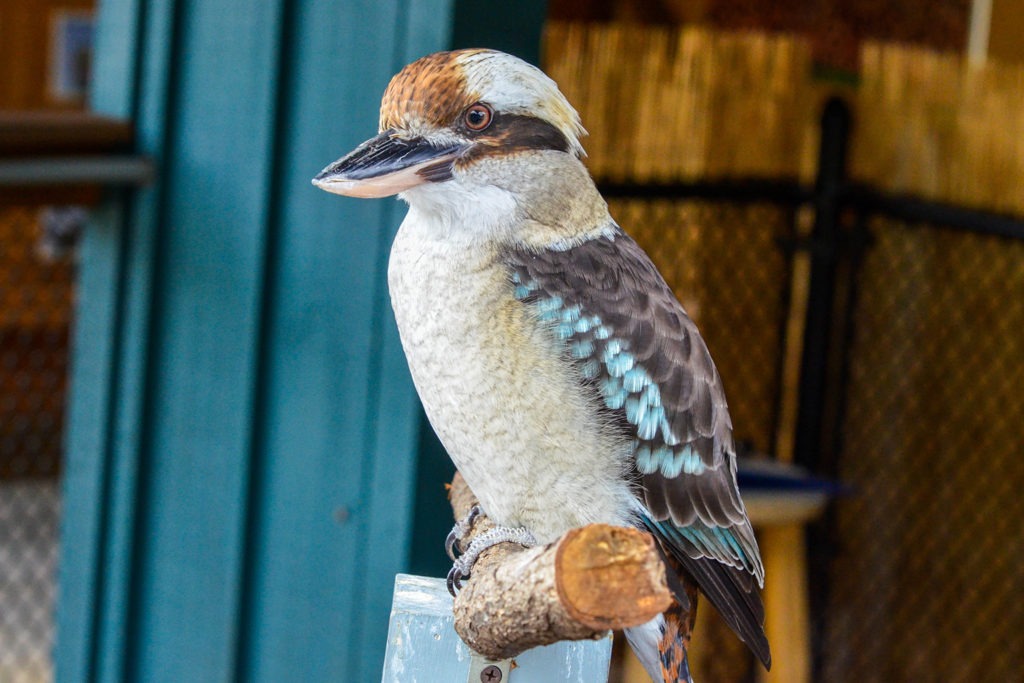Overview
“Where I live”
The kookaburra is native to eastern Australia but has also been introduced and established into other parts of the continent and offshore islands such as Tasmania. The kookaburra can be found living in open woodlands, forest, gardens, orchards, and parks.
The kookaburra is a featured species in The Maryland Zoo’s Animal Embassy collection. Zoo educators introduce the kookaburra and other Animal Ambassadors to audiences in education programs on and off grounds.
“How I live there”
Kookaburras are the largest of all kingfishers and are loud, talkative, highly territorial birds. They form small family groups and vocalize to advertise the boundaries of their territory. They are generally peaceful, but sometimes spar with other family members to establish a dominance hierarchy. Two birds will grab each other’s bills and twist and turn until one bird falls off its perch. The loser, clearly, is the de-perched one (seems sort of like a bird version of arm wrestling …)
Like other kingfishers, kookaburras have large heads, thick necks, stout bodies, and powerful bills. They are colored brown and white, with distinctive dark brown eye stripes. They belong to the subfamily of forest kingfishers.
Kookaburras are able “sit-and-wait” hunters. By day they perch in trees, survey the ground below, and swoop down to pounce on prey. They are carnivores that eat all sorts of small-sized prey, including insects, rodents, small snakes, and small birds. The kookaburra’s beak can crush small prey, but this same beak is not well-suited to ripping or tearing food. Necessity therefore forces a rather grisly meal scene. The kookaburra must beat larger prey against a branch or stone until it becomes rope-like and tears easily into bite-size morsels.
“Making my mark”
Kookaburra sits in the old gum tree,
Merry, merry king of the bush is he.
Laugh, kookaburra! Laugh, kookaburra!
Gay your life must be.
So goes the children’s song, and it describes the kookaburra well. This is a bird that commands attention and is best known for its laugh-like call. The call begins as a soft, rippling melody and swells to a loud “kook-kook-kook-ka-ka-ka.” As one kookaburra starts, others from the same family group join in and together they make a loud, raucous chorus. When calling, the birds are advertising their territory to others.
The call of the kookaburra is also known as the “bushman’s clock” in Australia. It can be heard early in the morning and shortly after sunset, telling the bushmen when to work. This bird also goes by the names “laughing kookaburra,” “alarm bird,” “breakfast bird,” and “ha ha pigeon.”
Raising Young
Kookaburras are monogamous birds that pair up in September and October during Australian springtime. Their courtship includes lots of vocalizing and dramatic display flights high over the treetops. Mates select a breeding territory and together build a nest in some sort of burrow, often very high up in a tree. A favorite burrow site is an abandoned termite mound way up in an acacia tree. Kookaburras also will nest in hollow trees, earthen banks, and holes in walls. Their burrows are up to two feet deep and have entrance holes about four inches wide.
The female lays one to five white eggs inside the nest chamber, and both male and female take turns incubating the eggs for the next 25 to 29 days. When they hatch out, the chicks are naked and blind but already almost adult size. They will remain in the burrow for about a month and have food delivered to them by both their parents and elder siblings. It’s a collective effort. By the time hatchlings emerge from the burrow, they are ready to fly. Their parents will continue to feed them for several more weeks, and the family group will stay together until the next breeding season. Kookaburras reach sexual maturity within a year.
“What eats me”
When threatened, a kookaburra will try to fly away or will puff up its feathers to look bigger and more threatening. Its most likely predators are cats and raptors.
Conservation
Populations of kookaburras appear to be stable and not at great risk.
Taxonomy
- Kingdom: Animalia
- Phylum: Chordata
- Subphylum: Vertebrata
- Class: Aves
- Order: Coraciiformes
- Family: Alcedinidae
- Genera: Dacelo
- Species: novaeguineae
What is an Animal Ambassador?
The Maryland Zoo refers to its special collection of education program animals as “Animal Ambassadors.” The Zoo currently cares for more than 60 Animal Ambassadors, representing more than 40 species, both native and exotic. These animals are managed separately from the rest of the Zoo’s collection and cannot be seen on exhibit at the Zoo. However, many can be seen up close and personal on a rotating basis at Creature Encounters, the Zoo’s outdoor education center; at camp and school programs at the Zoo; as featured participants in community-based Outreach programs; and at special events on and off Zoo grounds.
Animal Ambassadors spend countless hours working with their human handlers, developing bonds of trust and communication that will allow them to appear in front of audiences large and small. They are not show animals. They behave naturally, focusing audiences’ attention on their natural behaviors and adaptations and giving living, breathing meaning to concepts and topics that students may be studying.
Animal Ambassadors travel all over the state of Maryland and beyond, and many also make local and national media appearances, educating about wildlife while representing the Zoo and its commitments to animal welfare and conservation.
What is The Animal Embassy?
The Animal Embassy at The Maryland Zoo is an off-exhibit area that is not open to the public. It is where the Zoo’s “Animal Ambassadors,” or education program animals, live. The Embassy is home to more than 60 individual animals representing more than 40 different species. It is staffed by its own dedicated group of keepers and volunteers and has both indoor and outdoor living space for the animals.


